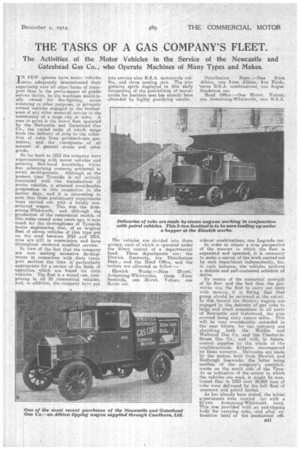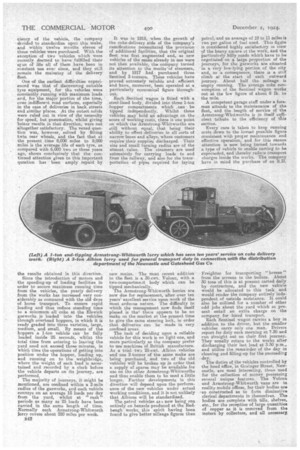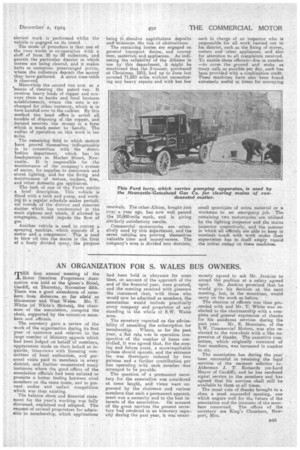THE TASKS OF A GAS COMPANY'S FLEET.
Page 25

Page 26

Page 27

If you've noticed an error in this article please click here to report it so we can fix it.
The Activities of the Motor Vehicles in the Service of the Newcastle and Gateshead Gas Co., who Operate Machines of Many Types and Makes.
IN FEW spheres have motor vehicles more adequately demonstrated their superiority over all other forms of transport than in the performance of public service duties, be the machines municipally owned for fire-fighting, street cleansing or other purposes, or privately owned vehicles engaged in the furtherance of any other essential service to the community of a large city or town. A case in point is the motor fleet operated by the Newcastle and Gateshead Gas Co., the varied tasks of which range from the delivery of coke to the collection of coins front private-house gasmeters, and the conveyance of all manner of general stores and other goods.
So far back as 1913 the company were experimenting with motor vehicles and securing first-hand knowledge whilst less enterprising concerns preferred to await developments. Although at the present time Tyneside is not actively associated with the manufacture of motor vehicles, it attained considerable prominence in this connection in the earlier days, and it is interesting to mite that. these preliminary experiments -were carried out with a locally conistructed wagon. This was the Armistrong-Whitworth, and although the production of the commercial models of this make ceased some years ago, it says much for tits thoroughness of Tyneside motor engineering that, of an original fleet of eleven vehicles of that type put on the road between 1913 and 1914, nine are still in commission and have throughout rendered excellent service:
In view of the fact that the company are now making extensive developments in connection with their transport services the time is' particularly appropriate for a review of the fields of operation Which are found for their vehicles. The fleet is a mixed one, comprising in all 22 commercial vehicles, and, in addition, the company have put into service nine B.S.A. motorcycle outfits, and three touring chrs. The progressive spirit displayed in this early recognition of the possibilities of motorcycles for busineis uses has already been attended by highly gratifying results.
Thr) vehicles are divided into three groups, each of which is operated under the direct control of a departmental head. These departments are: the Elswick Gasworks, the Distribution Dept., and the Head Office, and the motors are allocated as follow :—
Elswick Works :—Nine 29-cwt.
Armstrong-Whitworths, three 3-ton Sentinels, one 30-cwt. Vulcan, one Rover car. Distribution Dept. :—One 2-ton Albion, one 3-ton Albion, five Fords, 'seven B.S.A. combinations, one AngusSanderson car.
Head Office:—One 30-cwt. Vulcan, one Armstrong-Whitworth, two B.S.A.
sidecar combinations, one tagonda car. In order to obtain a true perspective of the manner in which the fleet is organized and operated, it is necessary to make a survey of the work carried out by each department independently, for, each instance, the vehicles perform a definite and self-contained schedule of duties.
By reason of the numerical strength of its fleet and the fact that the gasworks was the first to carry out tests with motors, it is fitting that that group should be reviewed at the outset. In this branch the thirteen wagons are engaged in the delivery of as coke to largel and small consumers in all parts of Newcastle and Gateshead, the area covered being sixty square miles. This will be very considerably extended in the near future, for the company are absorbing both the Walker and Virallsend Gas Co. and the Chester-leStreet Gas Co., and will, in future, control supplies to the whole of the neighbourhoods hitherto encompassed by these concerns. Deliveries are made by the motors bath from Elswick and Redheugh Gasworks, the latter being another of the company's establishments on the south side of the Tyne. As as indication of the extent to which the vehicles are used, it might be mentioned that in 1923 over 26,000 tons of coke were delivered by the full fleet of steamers and petrol lorries.
As has already been stated, the initial experiments Were carried ouk with a 20-cwt. Armstrong-Whitworth lorry. This was provided with an end-tipping body for carrying coke, and after exhaustive tests of the mechanical effi eiency of the vehicle, the company decided to standardize upoe this make, and within twelve months eleven of these vehicles were purchased. With the exception of two vehicles which were recently deemed to have fulfilled their span of life all of them have been in ccnstant use evere since, and they still remain the mainstay of the delivery fleet.
One of the earliest diffic-ulties experienced was that of discovering suitable tyre equipment, for the vehicles were constantly running with maximum loads and, for the major portion of the time, over indifferent road surfaces, especially in the case of deliveries in back, streets and similar places. At the outset solids were ruled out in view of the necessity for speed, but pneumatics, whilst giving better results in that direction, were not altogether satisfactory. The vexed question was, however, solved by fitting twin rear wheels, and the fact that at the present time 8,000 miles to 9,000 miles is the average life of each tyre, as compared with 6,000 two or three years ago, shows conclusively that the continued attention given to this important question has been amply repaid by the results obtained in this direction.
Since the introduction of motors and the speeding-up of loading facilities in order to secure maximum running time from the vehicles, the yearly delivery from the works has increased very considerably as compared with the old days of horse transport. To ensure rapid loading and thus reduce standing time to a minimum all coke at the Elswick gaeworks is loaded into the vehicles through overhead hoppers, in which it is ready graded into three varieties, large, medium, and small. By means of the hoppers a 1-ton vehicle can be fully loaded inside 25 seconds, whilst the total time from entering to leaving the yard need not exceed three minutes, in which time the operations of getting into position under the hopper, loading up, and running on to the weighbridge, where the weight of each load is weertained and recorded by a clerk before the vehicle departs on its journey, are performed.
The majority of journeys, it might be mentioned, are confined within a 2-mile radius of the gasworks, and each vehicle conveys on an average 15 loads per day from the yard, whilst at , rush ' periods as many as 25 loads have been carried in the same length of time. Normally each Armstrong-Whitworth lorry covers about 250 miles per week.
84.2
It was in 1915, when the growth of the coke-delivery side of the company's ramifications necessitated the provision of additional facilities, that the original fleet was first augmented and, as new vehicles of the make already in use were not then available., the company turned its attention to the merits of steamers, and by 1917 had purchased three Sentinel 3-tormers. These vehicles have proved extremely reliable and efficient and have, moreover, been operated at a particularly economical figure throughout.
Each Sentinel wagon is fitted with a steel-lined body, divided into three 1-ton hopper compartments which ,ean be tipped independently. Whilst these vehicles may hold an advantage on the score of working costs, there is one point on which the Armstrong-Whitworths are still without equal, that being their ability, to effect deliveries in all sorts of narrow lanes and alleys, where customers require their supplies discharged. Their size and small turning radius are of the utmost value. The steamers are used extensively for carrying loads to and from the railway, and also for the transportation of pipes required for laying
new mains. The most recent addition to the fleet is a 30-cwt. Vulcan, with a two-compartment body which can be tipped mechanically. The Armstrong-Whitworth lorries are now due for replacement, after over ten years' excellent service upon work of the most arduous nature. The difficulty in which the management now finds itself placed is that there appears to be no make on the market at the present time to give the same steering lock, in order that deliveries can be made in very confined areas.
The task of deciding upon a reliable vehicle for this work is no light one, and more particularly, as the company prefer to use machines of British manufacture. As a trial tyre 25-cwt. Albion vehicles and one 2-tanner of the same make are being purchased, and two of the old vehicles will be broken up in order that a supply of spares may be available for use on the other Armstrong-Whitworths and thus enable them to be used a little longer. Further developments in this direction will depend upon the performance of the new vehicles under actual working conditions, and it is not unlikely that Albions will be standardized.
The petrel vehicles are now being run entirely on benzole produced at the Bedbough works, this spirit having been found to give better mileage figures than petrol, and an average of 10 to 11 miles is run per gallon of fuel used. This figiire is considered highly satisfactory in view of the heavy nature ot the work, and the particularly hilly roads which have to be negotiated' on a large proportion of the journeys, for the gasworks are situated in a very low-lying portion of the city and, as a consequence, there is a stiff climb at the start of each outward journey. About half the mileage is empty running. The average coke consumption of the Sentinel wagon works out at the low figure of about 8 lb. to the mile.
A competent garage staff under a foreman attends to the maintenance of the fleet, and the length of service of the Armstrong-Whitworths is in itself sufficient tribute to the efficiency of this section.
Every care is taken to keep running ceste down to the lowest possible figure consistent with proper maintenance and effective operation, and for this reason attention is now being turned towards a type of vehicle to enable carting to be superseded, and thereby reduce transport charges inside the works. The company have in mind the purchase of an S.D.
Freighter for transporting " breeze" from the screens to the boilers. About 30 tone of this is at present carted daily by contractors, and the new vehicle would be allocated to this task and would render the company entirely independent of outside assistance. It could also be utilized for a number of other odd jobs about the yard which at present entail an extra charge on the company for hired transport. Each Sentinel wagon carries a boy in addition to the driver, but the smaller vehicles carry only one man. Drivers report for duty each morning at 7.30 and run straight out on their first journey, They usually return to the works after discharging their last load at 3.30 p.m., and utilize the remainder of the day in cleaning and filling-up for the succeeding day. The duties of the vehicles controlled by the head office, in Grainger Street, Newcastle, are most interesting, those used for the collection of money possessing several unique features. The Vulcan and Armstrong-Whitworth vans are in reality mobile offices, for their bodies are so constructed as to form diminutive clerical departments in themselves. The bodies are complete with tills, shelves, etc., for the reception of large quantities of copper as it is removed from the meters by collectors, and all necessary, clerical work is performed whilst the vehicle is engaged on its round.
The mode of procedure is that one of the vans works in co-operation with a staff of from 20 to '30 collectors, and patrols the particular district in which meters are being cleared, and it makes halts at numerous prearranged points, where the collectors deposit the money they have gathered. A strict time-table is observed.
Meanwhile the second van acts, as a means of clearing the patrol van. It receives heavy loads of copper and calveys them to banks and local business establishments, where the coin is exchanged for other currency, which is in turn handed over to the cashier. By this method the head office is saved all trouble of disposing of the copper, and inetead receives the money in a form ;which is much easier to handle. The radius of operation on this work is ten miles.
The remaining field in which motors have proved themselves indispensable is in connection with the distribution department, which has its headquarters in Market Street, Newcastle., It is responsible for the maintenance of the company's system of mains, for supplies to consumers and street lighting, and for the fixing and maintenance of meters, cockers, fires, and other domestic gas appliances. The task of one of the Fords merits a brief description. This vehicle is fitted with a tank and pump, and working to a regular schedule makes periodical rounds of the district and removes matter which has condensated in the main siphons and which, if allowed to congregate, would impede the flow of gas. Another vehicle is used to convey a spraying machine, which consists of a motor and a compressor. This is used to blow oil into the mains in the form of a finely divided spray, the purpose being b(a". -diesolve naphthalene deposits and-Minimize the risk of obstructions.
The remaining lorries are engaged on general transport duties, and convey men, materials and appliances. As indicating the reliability of the Albions in use by this department, it might be mentioned that the 2-tonner, purchased at Christmas, 1915, had up to June last covered 71,850 miles without neceesitating any heavy repairs and with but few renewals. The other Albion, bought just over a year ago, has now well passed the 10,000-mile m,ark, and is giving similarly satisfactory results. , Commercial motorcycles are extensively used by this department, and the seven vehicles are proving themselves valuable time and money-savers. The company's area is divided into districts, each in charge of an inspector who is responsible for all work carried out in his district., such as the fixing of stoves, meters and other appliances, and also for attention to all complaints received. To enable these officials—five in number —to cover the ground and make as many calls as possible per day, each has been provided with a combination outfit. These machines have also been found extremely useful at times for conveying
small quantities of extra material or a workman to an emergency job. The remaining two motorcycles are utilized by the lighting inspector and the mains inspector respectively; and the manner in which all officials are able to keep in constant touch with work under their supervision has in itself amply repaid the initial outlay on these machines.
































